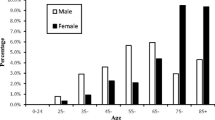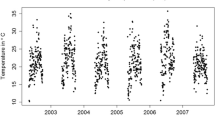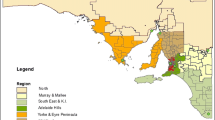Abstract
Heat kills more people than any other weather-related event in the USA, resulting in hundreds of fatalities each year. In North Carolina, heat-related illness accounts for over 2,000 yearly emergency department admissions. In this study, data on emergency department (ED) visits for heat-related illness (HRI) were obtained from the North Carolina Disease Event Tracking and Epidemiologic Collection Tool to identify spatiotemporal relationships between temperature and morbidity across six warm seasons (May–September) from 2007 to 2012. Spatiotemporal relationships are explored across different regions (e.g., coastal plain, rural) and demographics (e.g., gender, age) to determine the differential impact of heat stress on populations. This research reveals that most cases of HRI occur on days with climatologically normal temperatures (e.g., 31 to 35 °C); however, HRI rates increase substantially on days with abnormally high daily maximum temperatures (e.g., 31 to 38 °C). HRI ED visits decreased on days with extreme heat (e.g., greater than 38 °C), suggesting that populations are taking preventative measures during extreme heat and therefore mitigating heat-related illness.








Similar content being viewed by others
References
Alessandrini E, Sajani SZ, Scotto F, Miglio R, Marchesi S, Lauriola P (2011) Emergency ambulance dispatches and apparent temperature: a time series analysis in Emilia–Romagna, Italy. Environ Res 111(8):1192–1200
Anderson GB, Bell ML (2011) Heat waves in the United States: mortality risk during heat waves and effect modification by heat wave characteristics in 43 U.S. communities. Environ Health Perspect 119(2):210–218. doi:10.1289/ehp.1002313
Argaud L, Ferry T, Le QH, Marfisi A, Ciorba D, Achache P, Ducluzeau M, Robert D (2007) Short-and long-term outcomes of heatstroke following the 2003 heat wave in Lyon, France. Arch Intern Med 167(20):2177–2183
Baccini M, Biggeri A, Accetta G, Kosatsky T, Katsouyanni K, Analitis A, Anderson HR, Bisanti L, D’Ippoliti D, Danova J et al (2008) Heat effects on mortality in 15 European cities. Epidemiology 19(5):711–719
Bambrick H, Dear K, Woodruff R, Hanigan I, McMichael A (2008) The impacts of climate change on three health outcomes: temperature-related mortality and hospitalizations, salmonellosis and other bacterial gastroenteritis, and population at risk from dengue. Garnaut Climate Change Review. Available: http://garnautreview.org.au/CA25734E0016A131/WebObj/03- AThreehealthoutcomes/$File/03-A%20Three%
Basu R (2009) High ambient temperature and mortality: a review of epidemiologic studies from 2001 to 2008. Environ Health 8(1):40
Basu R, Samet J (2002) Relation between elevated ambient temperature and mortality: a review of the epidemiologic evidence. Epidemiol Rev 24(2):190–202. doi:10.1093/epirev/mxf007
Basu R, Pearson D, Malig B, Broadwin R, Green R (2012) The effect of high ambient temperature on emergency room visits. Epidemiology 23(6):813–820
Blum LN, Bresolin LB, Williams MA (1998) Heat-related illness during extreme weather emergencies. J Am Med Assoc 279(19):1514. http://www.ncbi.nlm.nih.gov/pubmed/9605881
Buckley JP, Richardson DB (2012) Seasonal modification of the association between temperature and adult emergency department visits for asthma: a case-crossover study. Environ Heal 11(55):1–6
Cao C, Weinreb M, Xu H (2004) Predicting simultaneous nadir overpasses among polar-orbiting meteorological satellites for the intersatellite calibration of radiometers. J Atmos Ocean Technol 21(4):537–542
Curriero FC, Heiner KS, Samet JM, Zeger SL, Strug L, Patz JA (2002) Temperature and mortality in 11 cities of the eastern United States. Am J Epidemiol 155(1):80–87
Golden JS, Hartz D, Brazel A, Luber G, Phelan P (2008) A biometeorology study of climate and heat-related morbidity in Phoenix from 2001 to 2006. Int J Biometeorol 52(6):471–480. doi:10.1007/s00484-007-0142-3
Gosling SN, Bryce EK, Dixon PG et al (2014) A glossary for biometeorology. Int J Biometeorol 58(2):277–308. doi:10.1007/s00484-013-0729-9
Grogan H, Hopkins PM (2002) Heat stroke: implications for critical care and anesthesia. Br J Anesth 88(5):700–707. doi:10.1093/bja/88.5.700
Gronlund CJ, Zanobetti A, Schwartz JD, Wellenius GA, O’Neill MS (2014) Heat, heat waves, and hospital admissions among the elderly in the United States, 1992–2006. Environ Health Perspect 122:1187–1192
Hart LG, Larson EH, Lishner DM (2005) Rural definitions for health policy and research. Am J Public Health 95(7):1149–1155. doi:10.2105/AJPH.2004.042432
Hartz DA, Golden JS, Sister C, Chuang W-C, Brazel AJ (2012) Climate and heat-related emergencies in Chicago, Illinois (2003–2006). Int J Biometeorol 56(1):71–83. doi:10.1007/s00484-010-0398-x
Hartz DA, Brazel AJ, Golden JS (2013) A comparative climate analysis of heat-related emergency 911 dispatches: Chicago, Illinois and Phoenix, Arizona USA 2003 to 2006. Int J Biometeorol 57(5):669–678. doi:10.1007/s00484-012-0593-z
Hess JJ, Saha S, Luber G (2014) Summertime acute heat illness in US emergency departments from 2006 through 2010: analysis of a nationally representative sample. Environ Health Perspect 122(11):1209
Hondula DM, Davis RE, Rocklöv J, Saha MV (2013) A time series approach for evaluating intra-city heat-related mortality. J Epidemiol Community Health 67(8):707–712
Kalkstein LS (1993) Direct impacts in cities. Lancet 342(8884):1397–1399
Kalkstein LS, Davis RE (1989) Weather and human mortality: an evaluation of demographic and interregional responses in the United States. Ann Assoc Am Geogr 79(1):44–64
Kilbourne EM, Choi K, Jones TS, Thacker SB (1982a) Risk factors for heatstroke: a case–control study. J Am Med Assoc 247(24):3332–3336
Kilbourne EM, Choi K, Jones TS, Thacker SB, Team FI (1982b) Risk factors for heatstroke. J Am Med Assoc 247(24):3332–3336. doi:10.1001/jama.1982.03320490030031
Klinenberg E (2002) Heat wave: a social autopsy of disaster in Chicago. University of Chicago Press, Chicago
Knowlton K, Rotkin-Ellman M, King G, Margolis HG, Smith D, Solomon G, English P (2009) The 2006 California heat wave: impacts on hospitalizations and emergency department visits. Environ Health Perspect 117(1):61–67. doi:10.1289/ehp.11594
Kovats S, Hajat S, Wilkinson P (2004) Contrasting patterns of mortality and hospital admissions during hot weather and heat waves in Greater London, U.K. Occup Environ Med 61:893–898
Li B, Sain S, Mearns LO, Anderson HA, Kovats S, Ebi KL, Patz JA (2012) The impact of extreme heat on morbidity in Milwaukee, Wisconsin. Clim Chang 110(3–4):959–976
Liang WM, Liu WP, Kuo HW (2009) Dirunal temperature range and emergency room admissions for chronic obstructive pulmonary disease in Taiwan. Int J Biometeorol 53:17–23
Lin S, Luo M, Walker RJ, Liu X, Hwang SA, Chinery R (2009) Extreme high temperatures and hospital admissions for respiratory and cardiovascular diseases. Epidemiology 20:738–746
Lippmann S, Fuhrmann C, Waller A, Richardson D (2013) Ambient temperature and emergency department visits for heat-related illness in North Carolina, 2007–2008. Environ Res 124:35–42. doi:10.1016/j.envres.2013.03.009
Luber G, McGeehin M (2008) Climate change and extreme heat events. Am J Prev Med 35(5):429–435. doi:10.1016/j.amepre.2008.08.021
Lugo-Amador NM, Rothenhaus T, Moyer P (2004) Heat-related illness. Emerg Med Clin North Am 22(2):315–327
Mackun P, Wilson S, Fischetti TR, Goworowska J (2011) Population distribution and change: 2000 to 2010 (No. C2010BR-01), 2010 census briefs. U.S. Department of Commerce, Economics and Statistics Administration, U.S. Census Bureau
May J (2009) Latino farmworkers in the Eastern United States. (Quandt SA, Arcury TA, eds.). New York, NY: Springer New York
Mayner L, Arbon P, Usher K (2010) Emergency department patient presentations during the 2009 heatwaves in Adelaide. Collegian 17(4):175–182
McGeehin MA, Mirabelli M (2001) The potential impacts of climate variability and change on temperature-related morbidity and mortality in the United States. Environ Health Perspect 109:185–189
Montz BE, Allen TR, Monitz GI (2011) Systemic trends in disaster vulnerability: migrant and seasonal farm workers in North Carolina. Risk Hazards Crisis Public Policy 2(1):1–17
Naughton MP, Henderson A, Mirabelli MC, Kaiser R, Wilhelm JL, Kieszak SM, McGeehin MA (2002) Heat-related mortality during a 1999 heat wave in Chicago. Am J Prev Med 22(4):221–227
Nelson NG, Collins CL, Comstock RD, McKenzie LB (2011) Exertional heat-related injuries treated in emergency departments in the U.S., 1997–2006. Am J Prev Med 40(1):54–60. doi:10.1016/j.amepre.2010.09.031
Ng CFS, Ueda K, Ono M, Nitta H, Takami A (2014) Characterizing the effect of summer temperature on heatstroke-related emergency ambulance dispatches in the Kanto area of Japan. Int J Biometeorol 58(5):941–948. doi:10.1007/s00484-013-0677-4
NOAA (National Oceanic Atmospheric Administration) (2007) Heat wave: a major summer killer. Available at: http://www.weather.gov/om/heat/heat_wave.shtml. Accessed 10 February 2015
North Carolina Department of Labor (2011) A guide to preventing heat stress and cold stress. Available: http://www.nclabor.com/osha/etta/indguide/ig35.pdf. Accessed 11 March 2015
North Carolina High School Athletic Association (2014) 2014–2015 heat and humidity guidelines from handbook. Available at: http://www.nclabor.com/osha/etta/indguide/ig35.pdf. Accessed 11 March 2015
North Carolina State Climate Office (2014). Overview of North Carolina. Available at: http://www.nc-climate.ncsu.edu/climate/ncclimate.html. Accessed 15 March 2015
O’Neill MS, Zanobetti A, Schwartz J (2005) Disparities by race in heat-related mortality in four US cities: the role of air conditioning prevalence. J Urban Health 82(2):191–197. doi:10.1093/jurban/jti043
Oberlin M, Tubery M, Cances-Lauwers V, Ecoiffier M, Lauque D (2010) Heat-related illnesses during the 2003 heat wave in an emergency service. Emerg Med J 27(4):297–299
Quandt SA, Wiggins MF, Chen H, Bischoff WE, Arcury TA (2013) Heat index in migrant farmworker housing: implications for rest and recovery from work-related heat stress. Am J Public Health 103(8):e24–e26. doi:10.2105/AJPH.2012.301135
R Development Core Team R: a language and environment for statistical computing, (2012), R Foundation for Statistical Computing Vienna, http://www.R-project.org Accessed September 2014
Rhea S, Ising A, Fleischauer AT, Deyneka L, Vaughan-Batten H, Waller A (2012) Using near real-time morbidity data to identify heat-related illness prevention strategies in North Carolina. J Community Health 37(2):495–500. doi:10.1007/s10900-011-9469-0
Saha S, Brock JW, Vaidyanathan A, Easterling DR, Luber G (2015) Spatial variation in hyperthermia emergency department visits among those with employer-based insurance in the United States—a case-crossover analysis. Environ Heal 14(1):20
Steadman RG (1984) A universal scale of apparent temperature. J Clim Appl Meteorol 23(12):1674–1687
Toloo G, Yu W, Aitken P, FitzGerald .G, Tong S (2014) The impact of heatwaves on emergency department visits in Brisbane, Australia: a time series study. Crit Care 18(2):R69
U.S. Census Bureau (2006–2010) Boston city, Massachusetts, DP02 selected social characteristics in the United States. 2010 American Community Survey 5-Year Estimates. Retrieved from http://factfinder2.census.gov
U.S. Energy Information Administration (2010) Residential energy consumption survey 2009. U.S. Energy Information Administration, Washington
Vandentorren S, Bretin P, Zeghnoun A, Mandereau-Bruno L, Croisier A, Cochet C, Ledrans M (2006) August 2003 heat wave in France: risk factors for death of elderly people living at home. Eur J Pub Health 16(6):583–591. doi:10.1093/eurpub/ckl063
Wang XY, Barnett AG, Yu W, FitzGerald G, Tippett V, Aitken P, Neville G, McRae D, Verral K, Tong S (2011) The impact of heatwaves on mortality and emergency hospital admissions from non-external causes in Brisbane, Australia. Occup Environ Med 29:163–169
Washington, Wyoming, Alaska, Montana, and Idaho (WWAMI) Rural Health Research Center (2004) Rural–urban commuting area codes (RUCAS) Available at: http://depts.washington.edu/uwrhrc/index.php. Accessed: 17 July 2014
Wichmann J, Andersen Z, Ketzel M, Ellermann T, Loft S (2011) Apparent temperature and cause-specific emergency hospital admissions in Greater Copenhagen, Denmark. PLoS ONE 6(7):e22904
Wood SN (2006) Generalized additive models: an introduction with R. Chapman and Hall/CRC
Wood SN (2011) Fast stable restricted maximum likelihood and marginal likelihood estimation of semiparametric generalized linear models. J R Stat Soc 73(1):3–36
Xiang J, Bi P, Pisaniello D, Hansen A, Sullivan T (2014) Association between high temperature and work-related injuries in Adelaide, South Australia, 2001–2010. Occup Environ Med 71(4):246–252. doi:10.1136/oemed-2013-101584
Xu Y, Dadvand P, Barrera-Gómez J, Sartini C, Marí-Dell’Olmo M, Borrell C, Medina-Ramon M, Sunyer J, Basagaña X (2013) Differences on the effect of heat waves on mortality by sociodemographic and urban landscape characteristics. J Epidemiol Community Health 67(6):519–525
Ye X, Wolff R, Yu W, Vaneckova P, Pan X, Tong S (2012) Ambient temperature and morbidity: a review of epidemiological evidence. Environ Health Perspect 120(1):19–28. doi:10.1289/ehp.1003198
Acknowledgments
This publication also developed under STAR Fellowship Assistance Agreement (no. F13D10708) awarded by the U.S. Environmental Protection Agency (EPA) and under the U.S. National Science Foundation through the Doctoral Dissertation Research Improvement (DDRI) award (Award Number 1434202). This project was also developed with support of the Southeastern Regional Climate Center (SERCC), North Carolina State Climate Office, and the Carolinas Integrated Science Assessments (CISA). The health data was supplied by the North Carolina Disease Event Tracking and Epidemiologic Collection Tool (NC DETECT). NC DETECT is a statewide public health syndromic surveillance system, funded by the NC Division of Public Health (NC DPH) Federal Public Health Emergency Preparedness Grant and managed through collaboration between NC DPH and UNC-CH Department of Emergency Medicine’s Carolina Center for Health Informatics. The NC DETECT Data Oversight Committee does not take responsibility for the scientific validity or accuracy of methodology, results, statistical analyses, or conclusions presented.
Author information
Authors and Affiliations
Corresponding author
Rights and permissions
About this article
Cite this article
Sugg, M.M., Konrad, C.E. & Fuhrmann, C.M. Relationships between maximum temperature and heat-related illness across North Carolina, USA. Int J Biometeorol 60, 663–675 (2016). https://doi.org/10.1007/s00484-015-1060-4
Received:
Revised:
Accepted:
Published:
Issue Date:
DOI: https://doi.org/10.1007/s00484-015-1060-4




